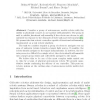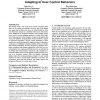143 search results - page 9 / 29 » Navigation control for mobile virtual environments |
PRESENCE
2010
13 years 6 months ago
2010
Brain–computer interfaces (BCIs) are becoming more and more popular as an input device for virtual worlds and computer games. Depending on their function, a major drawback is th...
ECAL
2005
Springer
14 years 1 months ago
2005
Springer
Consider a group of autonomous, mobile robots with the ability to physically connect to one another (self-assemble). The group is said to exhibit functional self-assembly if the ro...
FUZZIEEE
2007
IEEE
14 years 2 months ago
2007
IEEE
— The type-2 Fuzzy Logic Controller (FLC) has started to emerge as a promising control mechanism for autonomous mobile robots navigating in real world environments. This is becau...
RAS
2000
13 years 7 months ago
2000
We address the problem of visual-based navigation of a mobile robot in indoors environments. The robot control system is based on a single camera to provide the required visual fe...
IUI
2004
ACM
14 years 1 months ago
2004
ACM
The WALK mode is one of the most common navigation interfaces for 3D virtual environments. However, due to the limited view angle and low frame rate, users are often blocked by ob...


